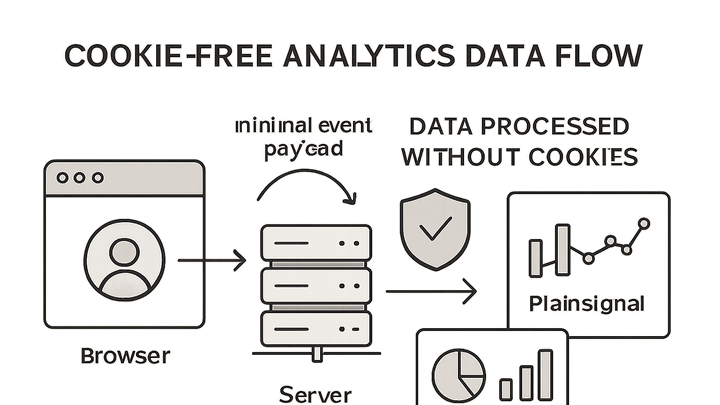Published on 2025-06-28T07:36:50Z
What is Cookie-Free Analytics? Examples for Cookie-Free Analytics
Cookie-Free Analytics refers to the practice of gathering website usage data without relying on browser cookies. It leverages server-side tracking, unique session tokens, and privacy-focused abstractions to respect user privacy and comply with regulations like GDPR and CCPA. As traditional third-party cookies are phased out, cookie-free analytics ensures businesses continue to understand user behavior across digital properties. Solutions like PlainSignal offer streamlined, lightweight tracking with minimal user data, while platforms such as Google Analytics 4 have built-in strategies for cookie-less environments. This approach prioritizes data accuracy, user privacy, and compliance, making it essential for modern analytics strategies.
Cookie-free analytics
Tracking user behavior without cookies using server-side methods and privacy-friendly tools like PlainSignal and GA4.
Introduction to Cookie-Free Analytics
Cookie-Free Analytics is a modern approach to web analytics that avoids the use of browser cookies. It emerged in response to growing privacy regulations and browser-level cookie restrictions. By focusing on server-side event collection and ephemeral identifiers, it balances data insights with user privacy. This section covers the fundamental concepts and historical context behind cookie-free tracking.
-
Definition
A method of collecting analytics data without storing cookies in the user’s browser, often using server-side logs and temporary session tokens.
-
Browser independence
Does not rely on client-side cookie storage, reducing data loss from cookie blocking.
-
Privacy focus
Aligns with GDPR, CCPA, and ePrivacy Directive by minimizing personal data collection.
-
-
Historical context
Became prominent as browsers limited third-party cookies and privacy laws tightened around user tracking.
-
Cookie deprecation
Major browsers like Safari and Firefox implemented Intelligent Tracking Prevention, limiting cookie lifespan.
-
Regulatory pressure
GDPR (2018) and CCPA (2020) increased legal requirements for user consent and data minimization.
-
How Cookie-Free Analytics Works
This section explains the technical underpinnings of cookie-free tracking, including server-side data collection and the use of unique session tokens to link user events.
-
Server-side tracking
Events and pageviews are captured by sending HTTP requests directly to an analytics server, bypassing browser-stored cookies.
-
Data flow
The browser or proxy sends minimal event data to a backend endpoint, which processes and attributes the event.
-
Advantages
Reduces data loss due to ad blockers or cookie restrictions and centralizes data processing.
-
-
Unique session tokens
Temporary identifiers generated per session or page load to group events without persistent cookies.
-
Token generation
Random or hashed string created at session start and discarded after a defined timeout.
-
Privacy impact
No long-term user profiling; tokens expire automatically, enhancing anonymity.
-
Implementing Cookie-Free Analytics with PlainSignal and GA4
A step-by-step guide to set up PlainSignal and Google Analytics 4 for cookie-free tracking, including code snippets and configuration tips.
-
PlainSignal setup
Integrate PlainSignal’s cookie-free analytics by adding their script to your site’s HTML.
-
Script integration
Place the following snippet in the <head> section of your HTML to enable PlainSignal tracking.
-
Example code
<link rel="preconnect" href="//eu.plainsignal.com/" crossorigin /> <script defer data-do="yourwebsitedomain.com" data-id="0GQV1xmtzQQ" data-api="//eu.plainsignal.com" src="//cdn.plainsignal.com/plainsignal-min.js"></script>
-
-
Google analytics 4 configuration
Configure GA4 to operate in environments with limited cookies using gtag.js and Consent Mode.
-
Enable consent mode
Use
gtag('consent', 'default', { ad_storage: 'denied', analytics_storage: 'denied' });to control cookie usage based on consent. -
Server-side tagging
Deploy a Server container in Google Tag Manager to forward events through your domain, bypassing cookie restrictions.
-
Benefits and Considerations
Analyzes the advantages and potential challenges of adopting cookie-free analytics, helping you make informed decisions.
-
Advantages
Key benefits for privacy, compliance, and data reliability.
-
Enhanced privacy
Minimizes personal data collection and aligns with user expectations.
-
Regulatory compliance
Simplifies adherence to GDPR, CCPA, and other privacy laws.
-
Future-proofing
Prepares analytics strategy for an ecosystem without third-party cookies.
-
-
Considerations
Potential limitations to be aware of before implementation.
-
Data gaps
Less granular insights due to lack of cross-site tracking and persistent identifiers.
-
Implementation complexity
Requires backend modifications or proxy setup for server-side collection.
-
Integration limits
Certain third-party marketing and personalization tools may still rely on cookies.
-
